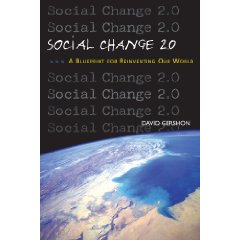
![]() Undeniable Genius Isolated from Other Movements
Undeniable Genius Isolated from Other Movements
January 4, 2010
David Gershon
This book is a work of undeniable genius and to that I would add peseverence–the author and his wife Gail Straub have been on the forefront of the personal empowerment movement from the late 1970's onward, and in many ways this book is a capstone work that bridges from the personal to the neighborhood and aspires to–but does not quite attain–the goal of being globally meaningful. I previously enjoyed and reviewed Low Carbon Diet: A 30 Day Program to Lose 5000 Pounds–Be Part of the Global Warming Solution! but this is the book that moves the author into my pantheon of a dozen world-class thinkers on social change.
Early on the book grabs me in a Buckminster Fuller sort of way when the author emphasizes that not only do we have to re-invent the world, we have to re-invent the process by which we re-invent the world. Of course Jonas Salk and others have addressed that with Epoch B leadership, but not for mention here.
I am totally impressed by the 30 years of hard work at the grass roots level that the author builds on in this book, one of the reasons it is a solid five stars on its own merits.
QUOTE from page 45: “The intial test results from the first 200 households were very promising. Those households on average reduced their annual solid waste by percent, water use by 32 percent, energy use by 17 percent, vehicle miles traveled by 8 percent, CO2 emissions by 15 percent, and achieved financial savings of $255.”
Those are HUGE accomplishments, and severely under-stated because the author does not factor in the “true cost” of the savings, probably closer to $10,000 a person if not vastly more (fuel is actually a million dollars a gallon if you really value the time it took to create the fossil base).
Continue reading “Review: Social Change 2.0–A Blueprint for Reinventing Our World”




